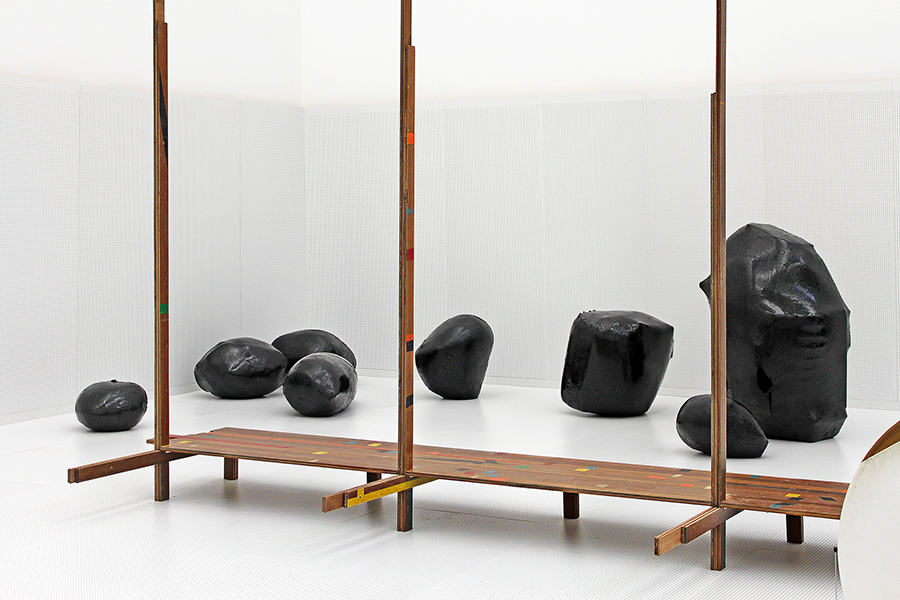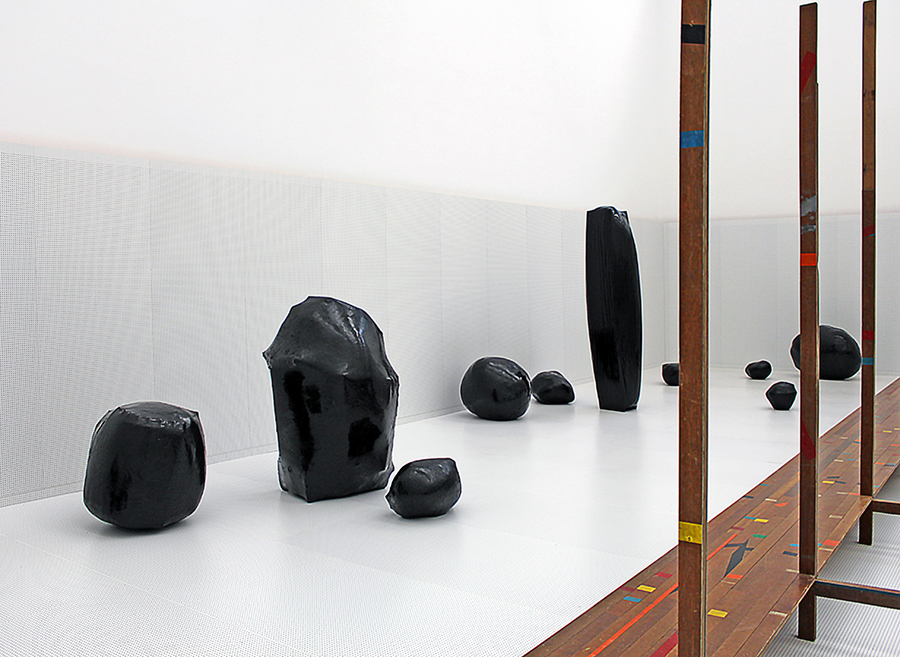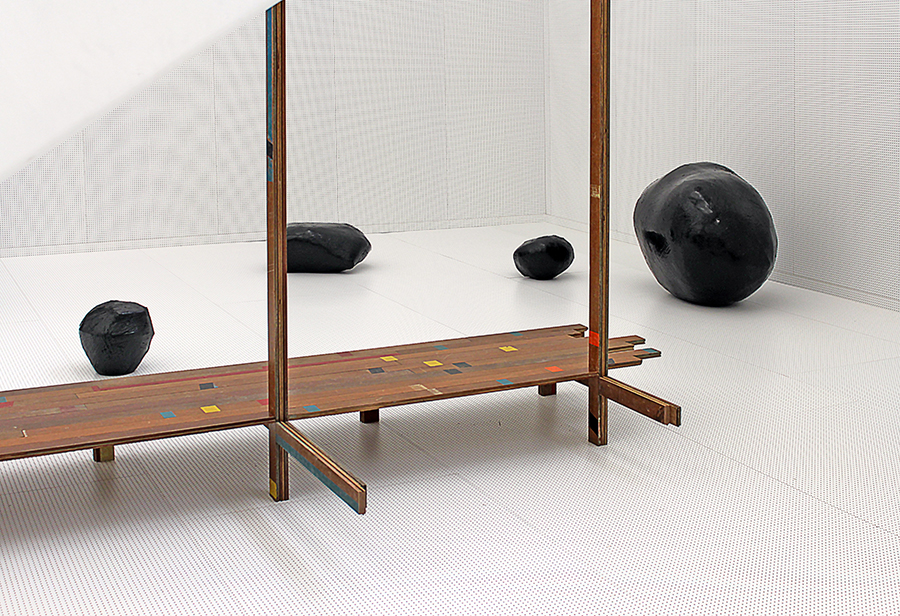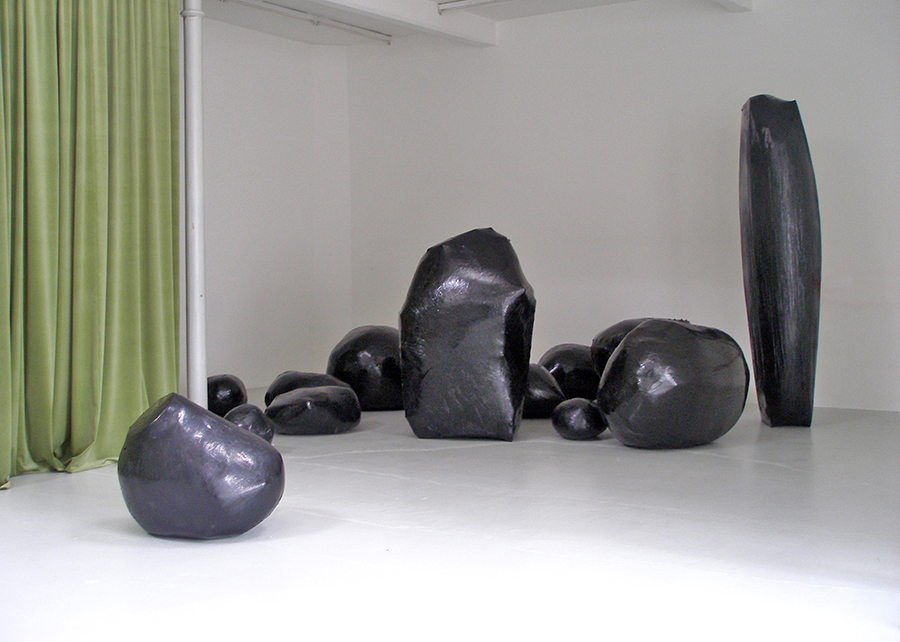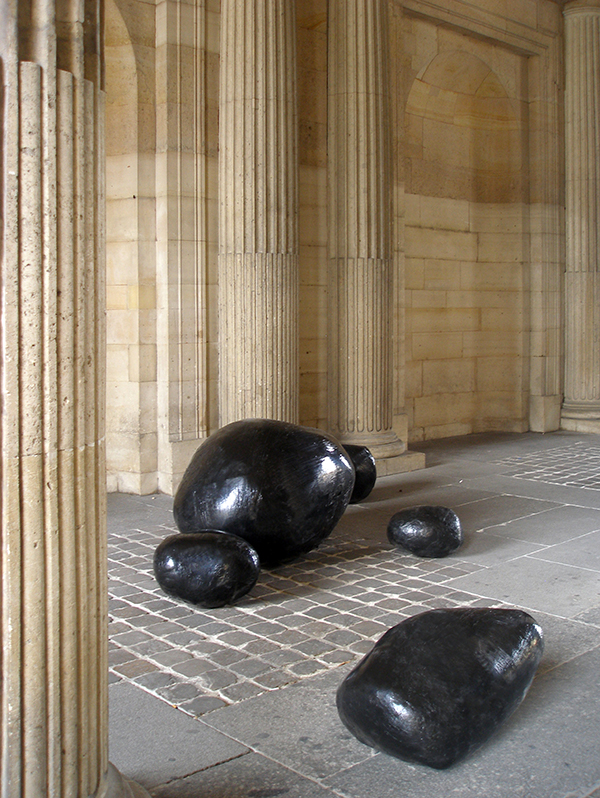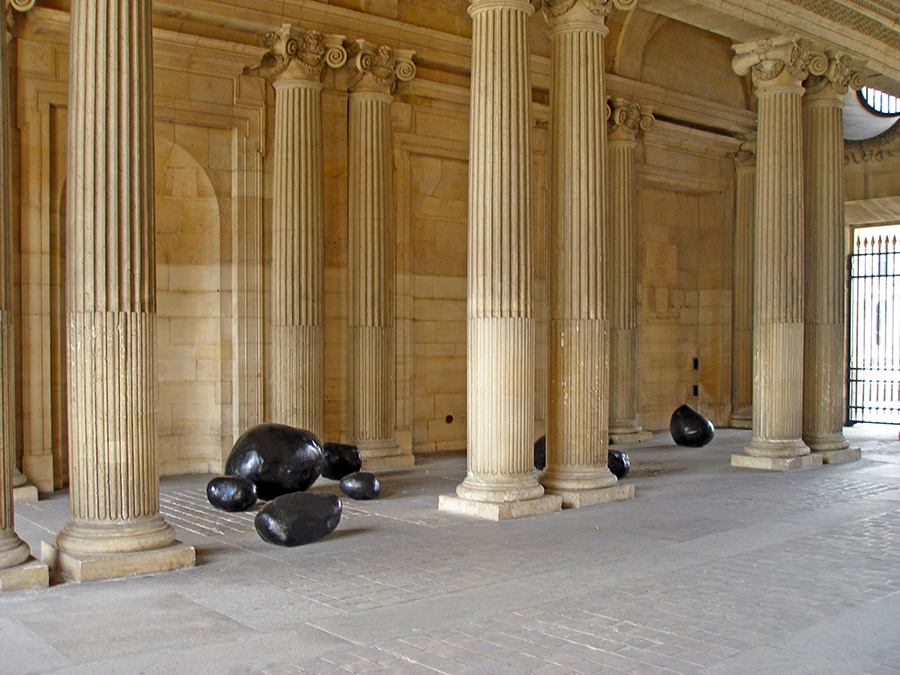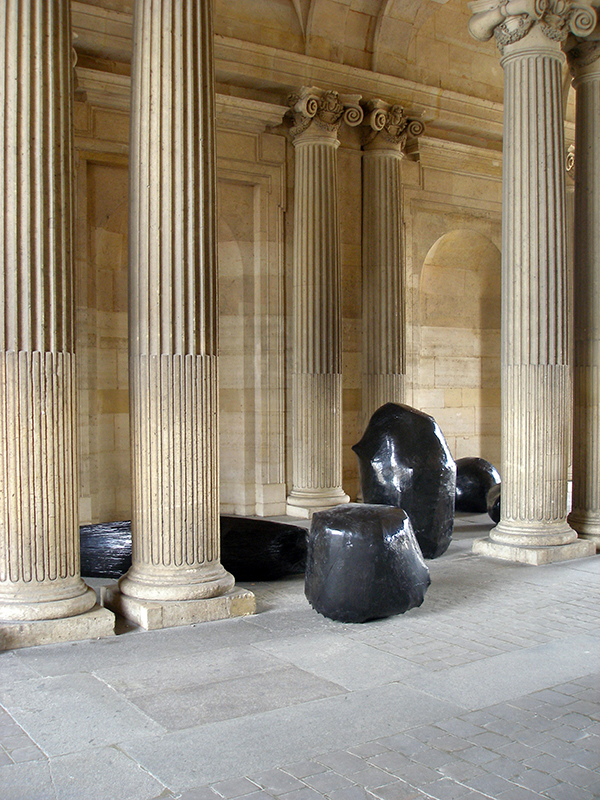Suchan Kinoshita
Isofollies, 2007-2017
Mixed media (wrape, plastic, oil), variable dimensions
Installation in Köln, museum Ludwig, exhibition “Suchan Kinoshita, In ten Minuten”
« Isofollies » (2007) de Suchan Kinoshita est une installation constituée de quatorze étranges météorites, des astéroïdes à la composition inconnue. Masses ventrues, volumes divers et singuliers, ces mégalithes agissent comme de monumentales scories : ce sont des ballots pétrifiés. Une première série de ces sculptures est apparue en 2006. Sur le lieu même de son exposition, dans les caves et greniers de la galerie qui l’accueille pour l’occasion, l’artiste a rassemblé, sérié, entassé des objets de rebut, des déchets de toutes sortes, ce qui au fil du temps a été abandonné, ce qui a perdu son utilité. Elle en a constitué des ballots de tailles diverses, elle a momifié au sens propre comme au sens figuré ces rebuts, les serrant dans de longues bandes de plastique industriel, élastique et noir, roulant ces balles sur le sol, les compressant, compactant ces déchets ainsi fossilisés. C’est le temps du lieu, son histoire, que voici pétrifié. Onze aérolithes constituent l’œuvre, distribués dans l’espace d’exposition comme une constellation3. En 2007, lors d’une exposition personnelle à l’Ikon Gallery à Birmingham sont apparus trois nouveaux aérolithes que l’artiste nomme désormais « Isofollies », du nom du plastique qu’elle utilise. Ce sont, cette fois, les résidus du montage de sa propre exposition qu’elle utilise. Le premier ensemble de ces sculptures devient ainsi un principe délocalisé.
Suchan Kinoshita est invitée en avril 2007, par la 8e biennale de Sharjah aux Emirats Arabes Unis. Avec son consumérisme effréné, ses îles artificielles, ses tours de luxe audacieuses, ses usines de désalinisation à énergie réduite et ses banlieues taillées dans les sables du désert, les Emirats Arabes unis sont le cauchemar des défenseurs de l’environnement. C’est cette problématique que les commissaires de la biennale ont décidé d’aborder : «Still Life, art, ecology and the political of change» est menée dans un urgent processus d’enquête et veut mettre l’accent sur le rôle renouvelé de l’art dans la résolution d’un large éventail de questions qui affectent directement, de façon alarmante, la vie telle que nous la connaissons. Il s’agit d’aborder les défis sociaux, politiques et environnementaux qui se posent face au développement humain excessif et l’épuisement progressif des réserves naturelles. Tout naturellement, Suchan Kinoshita propose de produire un troisième ensemble d’ « Isofollies ». Cette nouvelle constellation est bien évidemment produite in situ, avec les déchets et rebuts trouvés sur place. Né dans un dans un contexte domestique, temps compressé d’un lieu, recyclage du vécu de ses habitants successifs, le principe même de l’œuvre prend à Sharjah une signification augmentée et en quelque sorte planétaire.
Ces constellations successives agissent bien comme un espace de pensée à géométrie variable, du singulier au plus universel : Suchan Kinoshita a enfoui les rebuts d’une maisonnée, ensuite les résidus d’une production d’exposition, enfin un extrait condensé des déchets d’une mégalopole. Dans une quatrième déclinaison de l’œuvre, en 2014, elle a aussi enfoui les objets et souvenirs personnels d’une personne disparue, traces mémorielles qui acquièrent ainsi une nouvelle vivacité, abstraite et universelle. Rien n’est jamais figé dans l’œuvre de Suchan Kinoshita. Son travail protéiforme se développe sans cesse et se transforme avec les expériences accumulées. L’artiste considère chaque exposition comme le fragment d’un tout dont elle ne contrôle ni les limites, ni l’aboutissement. Bien que reliées entre elles par la volonté de l’artiste, les pièces dont elle est l’auteur s’enrichissent de connotations imprévues et peuvent se comprendre différemment selon les contextes spécifiques. Intéressant à cet égard est de considérer les divers moments et lieux où la constellation conçue à Sharjah est réapparue. Dans cette exposition dévolue à la « carrière du spectateur » (2009), certainement un job à temps plein, les quatorze éléments d’ « Isofollies », sont posés en contrepoint d’un monumental rideau de velours vert sur lequel, en poursuite, s’inscrit le halo lumineux d’un projecteur et derrière lequel tourne lentement sur elle-même une sphère à miroirs. Dans un rapport entre le tellurique et l’aérien, l’installation évoque une conjonction d’éléments qui renvoie à l’univers de René Magritte et ses mystères. Disposée en 2009 sous les voûtes du Pavillon de l’Horloge qui donne accès à la Cour Carrée du Louvre à Paris, « Isofollies » opère comme un chaos minéral face à l’ordonnancement classique des colonnes à cannelures érigées par l’architecte Jacques Lemercier au 17e siècle. Lors de son exposition « In ten minuten » (le temps est un paramètre essentiel dans l’oeuvre de Kinoshita) au Musée Ludwig à Cologne (2010) elles font face à cette autre œuvre que l’artiste nomme « Engawa », ponton en méranti, aux fines lattes de parquet ponctuées de lignes colorées et de petits carreaux jaunes, bleus et rouges, rythmé par une série de pilotis. L’engawa, dans l’architecture traditionnelle japonaise, est une passerelle de bois extérieure, un plancher surélevé, courant le long de la maison. C’est un lieu de passage, coiffé d’un toit pentu ; l’engawa module la relation entre l’intérieur et l’extérieur. On s’y arrête, on s’y assoit afin de contempler le jardin ou le paysage, on y médite. Ici, face à ce champ d’aérolithes qui rappelle l’épure totale du jardin japonais. Le « Sakuteiki », livre de conception du jardin, s’ouvre sur le titre de « L’art de disposer les pierres ». En 2011, lors de son exposition « The Right Moment at the Wrong place », au Museum De Paviljoens à Almere, elle concentre « Isofollies », dans un étroit et sombre réduit, retour à un obscur chaos des origines. Enfin, lors de l’exposition « Tussenbeelden » organisée à Schunck* (Heerlen 2014), le commissaire Paul Van der Eerden les compare aux « Bolis » de la culture Bambara, ces reliquaires manifestation de la force vitale dont la fonction principale est d’accumuler et de contrôler la force de vie naturelle. Ils contiennent des éléments divers, leur surface est sans cesse imprégnée de couches de libations. Pour l’initié, le « Boli » a une présence qui transcende l’objet lui-même ; objet réel dans un espace réel, il occupe aussi un espace mental dans la mémoire de la communauté.
Suchan Kinoshita
Isofollies, 2007-2017
Mixed media (wrape, plastic, oil), variable dimensions
Installation in Köln, museum Ludwig, exhibition “Suchan Kinoshita, In ten Minuten”
Suchan Kinoshita
Isofollies, 2007-2017
Mixed media (wrape, plastic, oil), variable dimensions
Installation in Liège (B), galerie Nadja Vilenne
Suchan Kinoshita
Isofollies, 2007-2017
Mixed media (wrape, plastic, oil), variable dimensions
Installation in Paris, Cour Carrée du Louvre.
Suchan Kinoshita’s Isofollies (2007) is an installation composed of fourteen strange meteorites or asteroids, their composition unknown. Bulbous masses, varied and singular volumes, these megaliths act like monumental scoria: they are petrified bundles. A first series of these sculptures appeared in 2006. In the exhibition space itself, in the basement and the attic of the gallery where she was showing, the artist gathered, serialized, and bundled up all manner of objects – waste, in fact, those things that over time had been abandoned, had stopped being useful. With these, she composed bundles of varying sizes; she mummified the scrap, literally and figuratively, by packing it using long strips of industrial plastic, elastic and black, and then rolling the resulting bundles on the floor, compressing them and thus compacting the fossilized waste. What is petrified here is the time of the place, its history. The eleven aeroliths that compose the work were distributed in the exhibition space like a constellation. In 2007, during a solo show at the Ikon Gallery in Birmingham, three new aeroliths appeared, and from that moment on the work took on the name Isofollies, after the plastic wrap used to make it. At the Ikon Gallery, she used the residues from the installation process of her show. The first ensemble of these sculptures thus became a delocalized principle.
Suchan Kinoshita was invited to the 8th Sharjah Biennial, in the United Arab Emirates, in April 2007. With its unbridled consumerism, its artificial islands, its ostentatious luxury towers, its ‘green’ desalination plants and its suburbs carved onto the desert sands, the United Arab Emirates are a nightmare for environmentalists. And that was precisely the problem that the artistic directors of the Biennial decided to address: Still Life, Art, Ecology and Political Change is inscribed in an urgent and ongoing research process whose goal is to highlight the renewed role that art can play in the resolution of a large panoply of questions that have a direct, and alarming, effect on life as we know it. It was about addressing the social, political and environmental challenges raised by excessive development and the ever-increasing depletion of natural resources. Naturally, against this background, Suchan Kinoshita decided to the produce a third set of her Isofollies. This new constellation was, like the other ones, produced in-situ, with waste and scraps found on the spot. Born in a domestic context, the compressed time of a place, a recycling of the lived experience of its successive inhabitants, at the Sharjah Biennial the very principle of the work took on a heightened, and in some ways planetary, meaning.
These successive constellations act like a space of thought with a variable geometry, from the singular to the more universal: Suchan Kinoshita buried the waste of a household, then the residues produced by the mounting of an exhibition, and lastly the condensed extracts of the waste of a megalopolis. In a fourth version of the work, from 2014, she buried the personal objects and souvenirs of a person who had died, traces of memories that in her work found a new vitality, at once abstract and universal. Nothing in Suchan Kinoshita’s work is ever fixed. Her shift-shaping work is always in progress, always being transformed in light of accumulated experiences. The artist always treats every exhibition like a fragment of a whole whose limits, and ends, are outside of her control. The works are linked by the will of the artist, but they are also enriched by unforeseen connotations and can be read differently depending on their context. It is interesting, in this regard, to consider the various moments and places where the constellation conceived for the Sharjah Biennial has reappeared. In this exhibition devoted to the ‘career of the spectator’ (2009), certainly a full-time job, the fourteen elements of the Isofollies were placed in counterpoint to a monumental green velvet curtain upon which a spotlight projected the luminous halo of a projector and behind which a disco ball turned slowly on its axis. In this relation between the telluric and the aerial, the installation evokes a conjunction of elements that refer to the universe of René Magritte and his mysteries. Placed under the archways of the Pavillon de l’Horloge, the eastern entrance to the Cour Carrée of the Louvre in Paris, the Isofollies operated like a mineral chaos amidst the classical layout of the fluting columns erected by the architect Jacques Lemercier in the seventeenth century. For her exhibition In Ten Minuten (time is an essential parameter of this artist’s work), at the Ludwig Museum in Cologne (2010), she placed the Isofollies in relation to another work, Engawa, a pontoon made of meranti wood cut into thin parquet slats, and dotted here and there by coloured lines and small yellow, blue and red squares, and punctuated by the stilts that support the structure, but that overshoot it in places. In traditional Japanese architecture, the engawa is a raised wooden walkway that surrounds the house, almost like a porch. It’s a passageway, covered by a slanted roof. The engawa mediates the relation between inside and outside. It’s a place to stand, to sit down and contemplate the garden or landscape, to meditate. In this case, a place to face the field of aeroliths so reminiscent of the total sparseness of the Japanese garden. The Sakuteiki, the oldest Japanese book about gardening, opens with the title ‘The Art of Setting Stones’. In 2011, for her show The Right Moment at the Wrong Place, at the Museum De Paviljoens, in Almere, the Netherlands, she concentrated the Isofollies into a narrow and dark enclave, a return to the obscure chaos of its origins. Finally, during the exhibition Tussenbeelden at the Schunck* (Heerlen, 2014), curator Paul Van der Eerden compared the Isofollies to the Bolis – reliquary manifestations of the vital force whose primary function is to accumulate and control the force of natural life of the Bambara people in West Africa. The Bolis contain a variety of elements, their surface is constantly impregnated by layers and layers of libations. For the initiated, the Boli is a presence that transcends the object itself; a real object in a real space, it occupies also a mental space in the memory of the community.
[sociallinkz]
